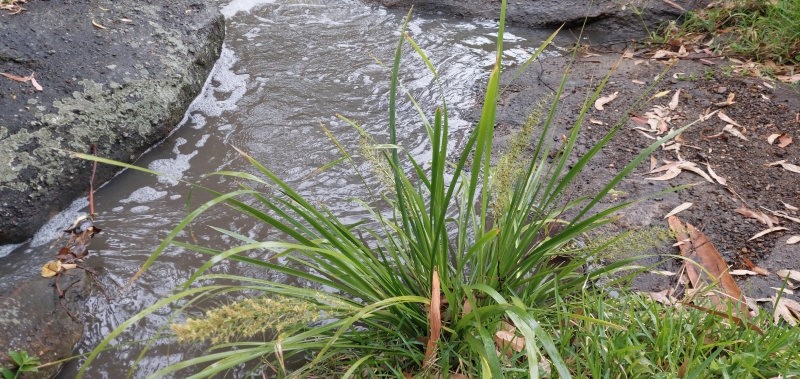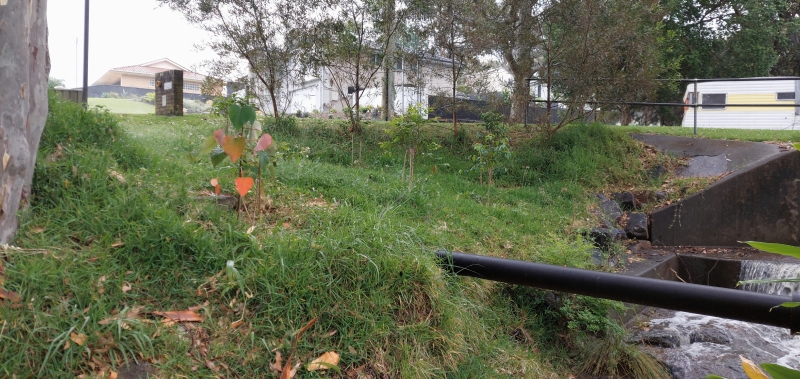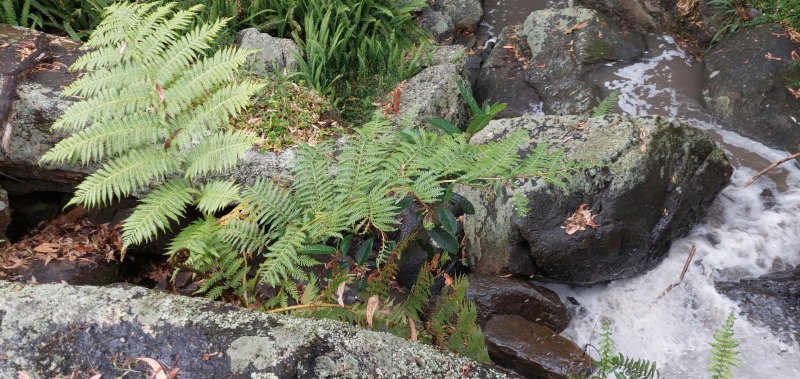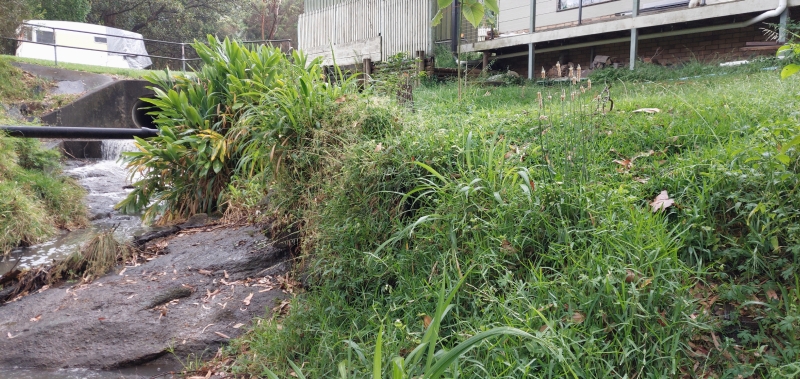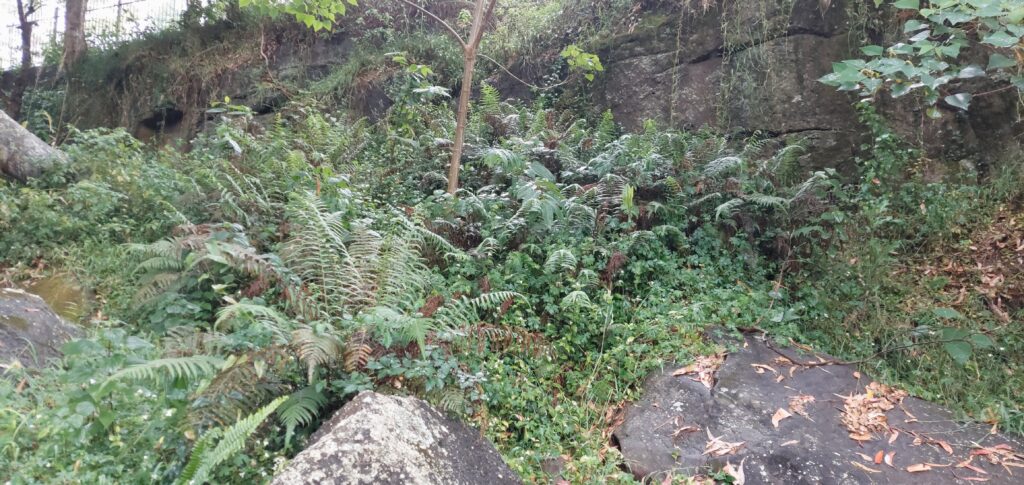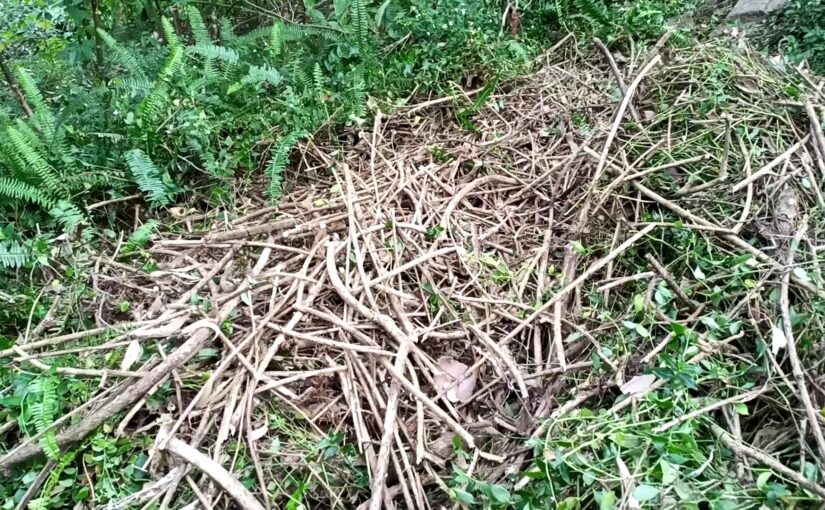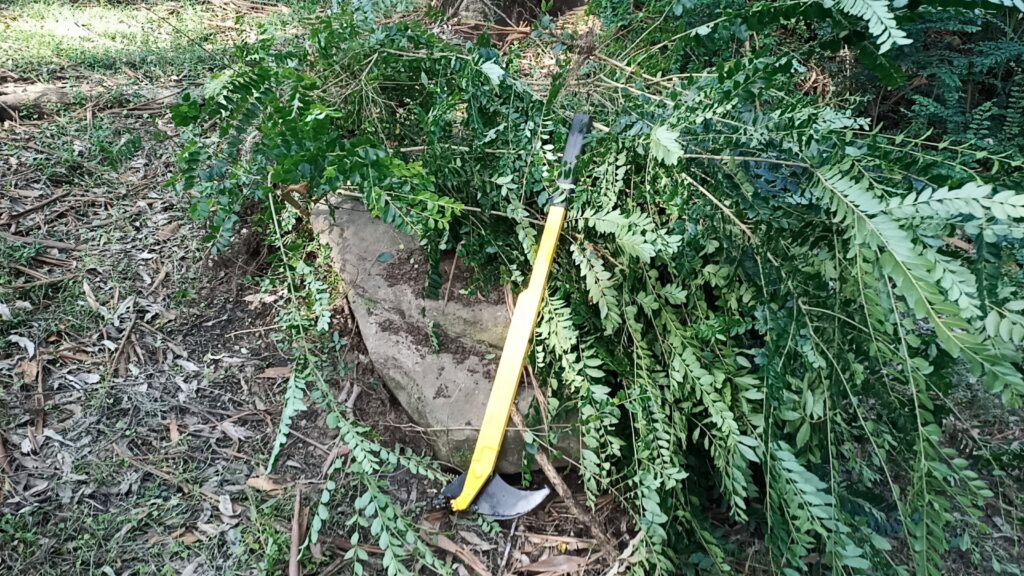THE OVERWHELMING REASON
They contain 15-18 biocidal toxins, most of which are moderately powerful. This tree in its most toxic types (‘chemotypes’) easily rank as the most toxic plant in Australian history, having up to an order of magnitude more toxic biocidal compounds than the average level of toxicity in most other exotic/Native toxic plant species!
ECOLOGICAL REASONS
1.Addicted/narcotised or over-consuming native bird species (excluding Crows and Northern Hemisphere species) are slowly disappearing/becoming extinct, especially small bird species and waterbirds (Davies, University of New England – Armidale).
2.In the drying circumstances of global warming, Camphor trees generally accumulate noxious and toxic weed species underneath them – three times as many weed species as all known native shrub or tree species known to survive underneath them.
3.Camphor trees harbour and promote more than a dozen other noxious species underneath their canopies (Three-Shire Survey over 5 years), of which 11 of 13 species of noxious weed are also toxic species. These species of toxic plants contribute to the cumulative toxification of native, unsuspecting fauna (insects, etc) eating them and of soft-bodied biota below, and in waterways especially.
4.On streams and rivers, banks are slowly undermined by roots exuding toxins (Kew Botanic Gardens) into sub-soils with most native riparian species suppressed, and some native tree species slowly killed out, especially on creek banks, waterways, rivers, etc. (Sainty 1989). Also, Camphor laurel tree roots are not densely branching like the original Native Coolamon trees which used to historically keep the riverbanks ‘flood-proof’.
5.Camphor laurels are a Northern Hemisphere pesticide tree-crop species, containing a volatile chemistry that can and does readily disturb the native ecological balance of southern Australian fauna and flora, which have for a million years or more had NO evolutionary contact (over geological timespans) with camphor and similar narcotic and other cumulative (sterilising) toxins.
CHEMICAL REASONS
6.Camphor laurels are rich in narcotics, including camphor, naphthalene and benzene – all moderately powerful narcotics and cumulative toxins that imbue addiction, i.e. wildlife/fauna (predisposed individuals) can become addicted after consuming bark, leaves, roots or berries.
7.Camphor is a fresh-scented, active constituent cryptically capable of attracting fauna to eat/consume significant quantities of the plant products (leaf, bark, fruit) because camphor percentages are generally over 50% of the plant oil.
8.Narcotics, including camphor, benzene, naphthalene and vanillin, are addictive, cumulative addictive, and may well cause increased addiction with increased concentrations in drought or due to carbon dioxide increases commensurate with global warming.
9.Sterilising compounds verified by Chinese researchers are also cumulative toxins, compounding the problems attributable to narcotic (‘addictable’) compounds, such that medium and/or long-term accumulations of narcotics and sterilising compounds may well be far worse than accumulations of both of these toxins separately.
10.Oxidation of camphor, in water, in summer heat, e.g. in a hot gutter/ing, can give rise to piperonyl butoxide, a very powerful pesticide synergist. Together, camphor and piperonyl butoxide (‘pip-bute’) are even more toxic, and represent the ‘unstated/intuitive reason’ why people will never place a water-tank under a Camphor laurel tree canopy.
EAST ASIAN KNOWLEDGE
11.In their native habitats of China, Japan, Taiwan and South Korea, camphors are not naturally on riverbanks or overhanging and dropping toxic parts into streams (Flora of Japan, Flora of Taiwan) and are actively kept away from waterways.
12.On mainland China, virtually all remaining Camphor trees are contained in managed plantation areas, which are regularly and sustainably harvested for seasonal oil production without allowing the trees to form flower or seed.
13.Australia received its first colonial transfer of Camphor laurels from Britain, taken by seed collectors to England (1747) from a remote island off Taiwan, and is the only country with a rare, 1881+ hybrid-crossing of Taiwanese island ssp. and Japan (Hiroshima) ssp. Our more toxic hybrids arose from this crossing and do appear to include “killer genes” (which also exist in Lauraceae, e.g. Puerto and Nabal Avocado leaves kill rabbits!).
BOTANICAL KNOWLEDGE
14.Floristic key to the different types or chemotypes (CRC-Friend 2003) proves that more toxic, or most toxic types exist in two ways: more carcinogenic (benzene, safrole compounds dominant) and narcotic and sterilising compounds dominant, as in camphor rich and double camphor % types.
15.Time lapse photography proves that increasingly more yellow or yellow-green type camphor trees are becoming more common, appearing to be linked to stress such as drought, higher temperatures (max+%) erratically, or the combined effects of ultraviolet irradiation, elevated carbon dioxide concentrations and temperature, etc.
16.At flowering, honeybees and native bees are totally deterred by the volatile narcotic Camphor, a well-known powerful insect repellent and killer compound – killing by asphyxiation in a closed space.
17.More toxic, carcinogenic chemotypes, rich in the pro-carcinogen Safrole, are not good shade trees, have poor morphological form, smaller leaves, and often don’t provide a reasonable leaf canopy.
18.Aerial infra-red photography proves that this is the only tree species able to grow all year round and hence able to manufacture toxins all year round.
19.Camphors can, and have, killed children and infants on three continents – Africa, Europe and North America.
20.Increasing numbers of asthmatic or hypersensitive reactions are occurring due to both acute and long-term exposure to Camphor and its 18 component, largely volatile, toxic constituents’ (Australia and U.S.A., California) cumulative toxicity.
21.At least five of the 18 toxic compounds in Camphor laurels are cumulative toxins due to medium or long-term exposure over sustainable timespans (12-15 years or more.)
22.Carcinogenic and pro-carcinogenic safrole is to be found in most parts of the tree’s bark and roots, as well as other parts of the tree, especially wood of the more toxic or ‘gaudy wood’ chemotypes.
23.Narcotics dull the brain, or cause narcosis by brain numbing, so the greater the output of volatiles like Camphor and Naphthalene etc., both soluble in Safrole (oil), the greater the probability of cumulative vapour breathing and metabolic fate (Overton 1901).
HEALTH REASONS
24.New Zealand (Aoteroa), with one of the highest set of health standards in the world, warned its population against the use of camphor and against planting Camphor laurels, by National Radio, in the 1960s. If this is an agreed upon ‘Excellent Standard’, then why not spread it worldwide? (‘IBP’ applies = International Best Practice.)
25.Practical farm/landowners throughout eastern Australia’s seaboard know “not to” place water tanks, or drinking-water collection gear under or nearby Camphor laurel trees, as water will become unfit for human use.
LEGAL REASONS
26.Germany has a complete ban on all trade in camphor since 2002, as it is now known as a moderately powerful narcotic and as a compound base from which other drugs, e.g. ecstasy, can be manufactured illicitly.
27.Importation of camphor or camphorated oils to the European Community and America is now strictly controlled and regulated.
28.In the High Court of Australia in 2002, Old English Law was overturned and nullified in Australia, giving Sydneysiders or Australians everywhere the right to remove any street-side Camphor laurel physically destroying sandstone walls or foundations, and seriously damaging footpaths and gutters. (More toxic chemotypes lost by appeal to the High Court.)
29.Australia’s remnant or rare threatened and endangered fauna (and flora) deserve better protection from volatile toxic tree species that deter pollinators and kill helpful pollinating wildlife.
ENVIRONMENTAL PROTECTION
30.Hydrology – Camphor laurels use more water than any other tree species (to manufacture up to 18 toxins interseasonally), valuable water that is needed for native fauna and flora regeneration; stream flows are often reduced by an estimated 40% – as compared with native trees’ water demand.
31.Fish deaths by fish poisons – naphthalene and camphor in combination are especially toxic to soft-bodied organisms (Overton 1898, 1901, U.S.-EPA 1991). As naphthalene is a fish poison (piscicide) and camphor oxides in certain waters to form piperonyl butoxide, in ‘ppb’ this will synergise and make the impact of naphthalene worse in water.
32.High safrole chemotypes or safrole-dominant types of Camphor laurel trees are deadly to most plants and animals underneath them. If and where safrole% in Camphor laurel oil camphor% then camphor is fully absorbed into the safrole oil (Martindale 2000) and fails to repel the organism. Safrole is ingested and both do their damage without the organism being or becoming at all aware. Result: slow steady death of fauna, over long-term timespans – not readily observed.
33.Paralysis and ensuing death of fauna, as observed in a rising tide of recently dying roadside wildlife, is no doubt due to the alkaloid neticulene and laurolitsene which are known since 1968 to come from the root bark.
34.Veterinarians have repeatedly diagnosed “C.N.S.-paralysis”, principally RHS of brains of birds, found by dissection to be full of Camphor laurel fruit in the crop or stomach.
35.Since 1979 (Firth, N.S.W. Agriculture [DPI], Alstonville) two main Camphor laurel types are recognised in scientific journals and one UNE thesis, and both can and do cause differing colourful ‘stream deaths’ (Friend, CRC 2000; Schenk 2004, S.C.U. Lismore).
36.Our air, streams and waterways should be being monitored, and none is as yet, for the serious toxic organic pollutants, the botanical pesticidal and narcotic components of all or any exotic weed species such as Broad Leaved Privet, known to be able to kill native bird species (reference: Toxic Plants of North America). Streams and waterways in valley floors act as ‘collecting reservoirs’ for the long-hot summertime expelled volatile toxins of Camphor laurel trees.
37.All schools in all eastern states need to replace all camphors with native trees, in a stepwise fashion, as part of teaching children and students about the risks of toxic plants.
GENETIC REASONS
38.Six decades after the first hybrid Camphor trees were reported (1901, The Northern Star) as spreading west from Bangalow, they had become a native canopy problem in the same area. Most Camphor laurels take only 3-10 years to start seeding, so they have a relatively low generation time, sped on by bird dissemination, mostly by vomiting of fruit and seeds. Genetic diversification has been ongoing for 123 years since Japanese and Taiwanese camphors first ‘crossed’, at or near Burringbar, north of Mullumbimby. Theoretically, Weed Management authorities have to contend with 12 generations of genetic advancement, assuming a conservative 10 years per generation.
39.Genetic diversity within the species Cinnamomum camphora in north-eastern NSW may be assumed to be greatest here cf. other parts of Australia, although it is not known if any legal or illegal mainland Chinese immigrants, or miners, brought the prized seeds in small leather pouches (anecdotal contribution to genetic interbreeding?; not proven).
40.Camphor laurel is a first cousin or relative of the Amazonian poison tree, the Ocotea, or blow dart tree, extracts from which are only slightly less powerful as mammal poisons than curare vine, It is a relative of the family Lauraceae (Ref.
41.Being already the most toxic plant species in Australia and having toxicity genes for at least five differing groups of poisonous compounds, and bearing in mind that plant chemistry evolved long before fauna appeared on earth, Camphor laurels are well positioned to be one of the great survivors on the planet as it becomes increasingly polluted.
FEDERAL-NATIONAL REASONS
42.Camphor laurel is the most toxic weed species in Australia today. No other plant species comes even close to having 18 biocidally active toxins, and certainly not, usually, any cumulative toxins. Cinnamomum camphora needs to be included in the ‘worst’ list – ‘The Worst Twenty Weeds’ (WON S List) in Australia (Canberra).
43.In 1955 Camphor laurel was the reason that the NSW Poisonous Plants Committee was disbanded, or retrenched, by the NSW Government. As compensation, this should be the primary reason that a Federal or State-Federal Toxic Plants Advisory Committee or Scientific Advisory Group needs forming.
EVOLUTIONARY REASONS
44.Solid evidence has been recently collected, on Norfolk Island and the mainland, indicating that Camphor laurel is becoming increasingly more toxic due to global warming, with new hybrids spreading their range to include new, novel habitats, e.g. in mangrove estuaries, and intertidal areas – even below the average high water mark (Friend, CRC 2002), e.g. on South Stradbroke Island (Qld).
45.Surveys of current and old time timber milling staff, Directors, ex-staff, and individual loggers and foresters, reveal that across north-eastern NSW many fellers and millers have known in their own lifetimes or that of their fathers that different types of camphor tree could be selected from bark type, branching type, etc., to obtain the best wood for their purposes.
46.Spread of the species’ geographic range, to now include the NSW Northern Tablelands, and some inland areas (e.g. Dubbo, Tamworth, Uralla and Tenterfield, and Alice Springs, NT,) shows that it is now known to produce viable seed in drier, warm autumns as well as to germinate in low/no-frost winters, e.g. at Tenterfield, and on the Nicholson River floodplain, southeast of Melbourne, Victoria – as confirmed by Melbourne’s Botanic Gardens staff, 2001-02. This is indicative of evolutionary change and selection/survival of hardier ‘cold resistant’ types.
47.Consistent logging of Camphor laurels for over 60 years – which arguably reached its economic zenith in 1946 near Lismore with the export of veneer (>$1 million p.a.) – has resulted in a forest population of known more toxic types in abundance, preponderant over the less toxic types which are favoured for their even grain, creamier, better curing and less knotty timber.
AGRICULTURAL REASONS
48.Camphor laurels can and have killed numerous stock, especially horses in NSW Northern Rivers and Southeast Queensland, from consuming Camphor laurel bark and/or leaves in drought times; since 1942 in NSW and officially recognised by Plant Toxicologist Dr. Ross McKenzie in Queensland.
49.Entire herd of goats (8-12) killed by force-feeding on Camphor laurel (pruned/lopped) branches and leaves, Kempsey High School, in summer 2001.
50.Camphor laurels reduce many tree crop yields around farm peripheries, as Camphor laurel tree roots invade into farmland, up to 100m, a consistently proven fact (Northpower staff, 1970-2000), especially for small-crops.
51.Camphor laurels coming up in pastures help get cattle addicted to the species, leading to noticeable ‘livestock wasting’, and decline by cows on especially weedy farms has been noted and proven (at saleyards), with occasional death of cows due to camphor addiction, confirmed since 1942 (Everist, NSW Poisonous Plants Committee, text, @ Royal Botanic Gardens, Sydney).
52.Birds eating Camphor berries in dry times become sick, vomiting seeds along fencelines, and small bird species die out in drier areas, slowing reducing ecological on-farm biodiversity, but building up camphor and weed numbers at the expense of native biodiversity.
VETERINARY REASONS
53.Koalas, in both Lismore and Mullumbimby districts since 1991, have been known to become addicted to regular night-time feeding on Camphor laurel leaf, but in the course of choosing leaf to eat, they eat some more toxic bark, and worse toxins in that (Hiraizumi 1950) cause the speedy demise of individual koalas. They fall from trees sick/dead, frothing from the mouth, with full stomachs reeking of camphor (G. Tomkins, Veterinarian/’Friends of the Koala’ Adviser, Lismore); yet no pathology laboratory is geared-up to even analyse for camphor, to prove the connection – let alone mention the other toxins.
54.Possums have recently (2004, May and June) been found dead, warm and entire (not run over) in the middle of Lismore roadways, with front legs crossed, eyes and other organs dilated, stomach with camphor and purple snouts from eating Camphor laurel, and found directly under entire interlocking Camphor laurel tree canopies over narrow country roads. Evidence is overwhelming in other cases of possum death and symptoms of ‘anaphylactic shock’ – the reason that all camphor is banned in German trade (import and export).
55.Wallabies, now seen through binoculars/multiple observations in three districts consuming significant volumes of toxic Camphor laurel bark, including whole tree seedling/s in one case, may well be declining in population numbers due to excess consumption: addiction to Camphor laurel narcotics.
56.If camphor consumption is ‘so good’ for native fauna (bandicoots, koalas, possums and wallabies), repeatedly attested by certain influential, conservative observers, then how is it that all these species are not becoming increasingly more common across the Northern Rivers region of NSW? In fact, the opposite is the case, where sightings of fauna are now uncommon, seasonal events in most district of the one fauna-rich region.
ENTOMOLOGICAL REASON
57.In 1970/71 McCubbin’s ‘Butterflies of Australia’ declared that the Blue Triangle Butterfly (Graphium graphium) enjoyed its main/principal host plant species Camphor laurel trees, or at least the lower limbs and leaves thereon. Since that date there have been 35 years for this brilliant native butterfly species to adapt to its/all toxins (18) known to be manufactured by this tree species. Instead, its population has declined, as proven by three years of springtime branch sampling and close inspection and observations of Camphor Laurel trees in Lismore NSW.
Its a shame cause their nice trees otherwise 
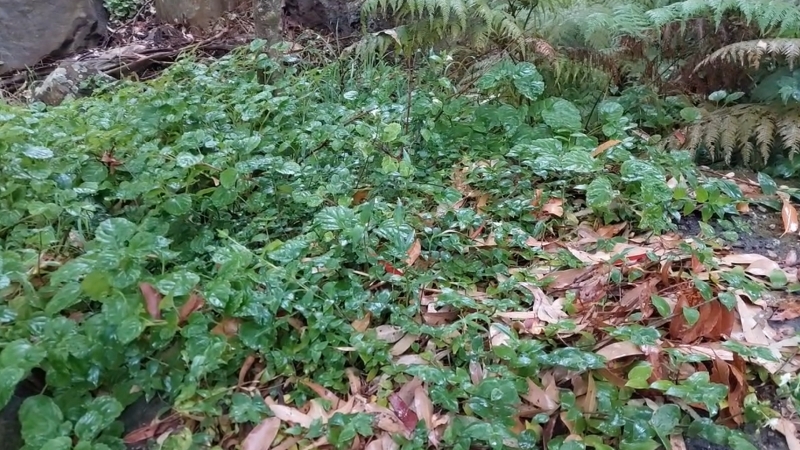 It is not all bad though… Various natives are still hanging on as can be seen in this clip:
It is not all bad though… Various natives are still hanging on as can be seen in this clip: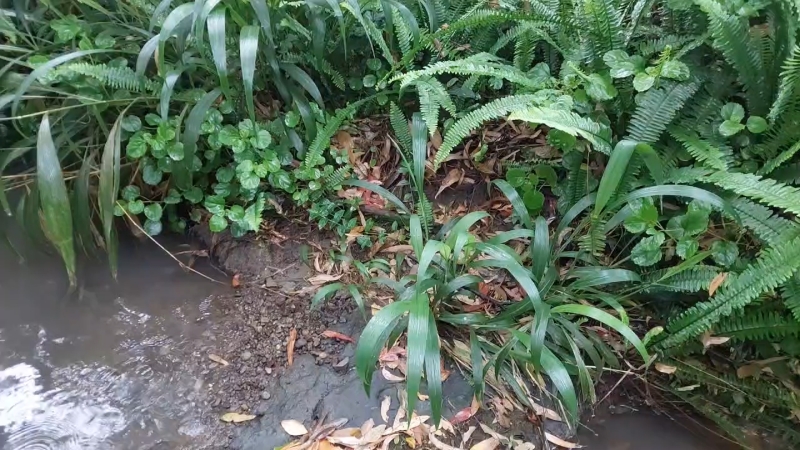 I had previously planted them at this location when there was a lot more soil on the bank. Ironically, the intention was to reduce erosion. Considering sandpaper fig’s ability to grow in the most unlikely of spots, I was thinking they would make it here. However, we had some big rain events since then and clearly this spot was not protected enough to stop them from being swept away. Who knows, maybe they found a spot further down stream…
I had previously planted them at this location when there was a lot more soil on the bank. Ironically, the intention was to reduce erosion. Considering sandpaper fig’s ability to grow in the most unlikely of spots, I was thinking they would make it here. However, we had some big rain events since then and clearly this spot was not protected enough to stop them from being swept away. Who knows, maybe they found a spot further down stream…